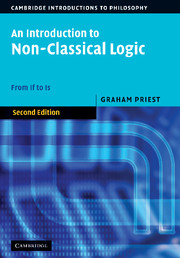Book contents
- Frontmatter
- Contents
- Preface to the First Edition
- Preface to the Second Edition
- Mathematical Prolegomenon
- Part I Propositional Logic
- Part II Quantification and Identity
- 12 Classical First-order Logic
- 13 Free Logics
- 14 Constant Domain Modal Logics
- 15 Variable Domain Modal Logics
- 16 Necessary Identity in Modal Logic
- 17 Contingent Identity in Modal Logic
- 18 Non-normal Modal Logics
- 19 Conditional Logics
- 20 Intuitionist Logic
- 21 Many-valued Logics
- 22 First Degree Entailment
- 23 Logics with Gaps, Gluts and Worlds
- 24 Relevant Logics
- 25 Fuzzy Logics
- Postscript: A Methodological Coda
- References
- Index of Names
- Index of Subjects
23 - Logics with Gaps, Gluts and Worlds
Published online by Cambridge University Press: 05 June 2012
- Frontmatter
- Contents
- Preface to the First Edition
- Preface to the Second Edition
- Mathematical Prolegomenon
- Part I Propositional Logic
- Part II Quantification and Identity
- 12 Classical First-order Logic
- 13 Free Logics
- 14 Constant Domain Modal Logics
- 15 Variable Domain Modal Logics
- 16 Necessary Identity in Modal Logic
- 17 Contingent Identity in Modal Logic
- 18 Non-normal Modal Logics
- 19 Conditional Logics
- 20 Intuitionist Logic
- 21 Many-valued Logics
- 22 First Degree Entailment
- 23 Logics with Gaps, Gluts and Worlds
- 24 Relevant Logics
- 25 Fuzzy Logics
- Postscript: A Methodological Coda
- References
- Index of Names
- Index of Subjects
Summary
Introduction
23.1.1 This chapter brings together the techniques of previous chapters, to look at a variety of logics that they may generate. The chapter also acts as a bridge between the basic system of relevant logic of the last chapter, First Degree Entailment, and the full relevant logics of the next.
23.1.2 By this stage of the book we have many independent techniques that may be employed in constructing the semantics of a logic: normal and non-normal worlds, constant and variable domains, different numbers of truth values, negation using many values and the * semantics, necessary and contingent identity. These techniques can be combined to produce a vast variety of logics, far too many to consider here. We will consider only some of the more notable ones.
23.1.3 We begin with the basic relevant logics N4 and N*, starting with the former. This will require an application of the matrix semantics employed for non-normal modal logics in chapter 18. The logics K4 and K* are then obtained as special cases. We will look only at the constant domain versions of the logics.
23.1.4 Identity for the logics in question is next on the agenda. We will concern ourselves only with necessary identity, though the behaviour of identity at non-normal worlds gives it something of the flavour of contingent identity.
23.1.5 There is then a philosophical interlude concerning one application of identity in relevant logic: relevant predication.
Information
- Type
- Chapter
- Information
- An Introduction to Non-Classical LogicFrom If to Is, pp. 504 - 534Publisher: Cambridge University PressPrint publication year: 2008
